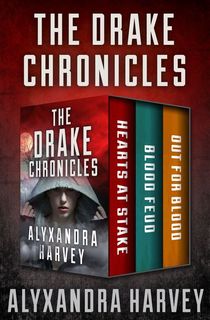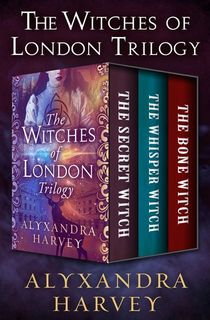I admit it.
I still like vampires.
I know vampire fatigue is bordering on being a medical malaise, but give me a good undead protagonist who I can quiz about Anne Boleyn and Robin Hood and Marie Antoinette, and I’m a happy girl. I want to know what they ate, if their shoes pinched, and why everything in the Regency seems to be made of calf’s foot jelly. Because ew.
Just because vampires are dead, doesn’t mean they can’t have manners. The vampires in my series The Drake Chronicles have been around long enough to know how to use a napkin. Except for the Hel-Blar, who are inspired by Norse revenant myths. They’re just gross. And that’s something else I love about vampires: there are so many versions! Here are eight of my favorite literary vampires.
RELATED: 10 Vampire TV Shows That Don't Suck

Blood Price
One of my favorite vampires is Henry Fitzroy from Tanya Huff's Blood Ties series, because he is the undead bastard son of Henry VIII, currently living in Toronto as a romance novelist. Every single thing in that sentence is awesome! Henry is also wonderfully snarky, but still only half as snarky as our kick-ass heroine Vicki. I have loved him since I was 16. Fight me.
RELATED: 18 Bloody Good Vampire Books

The Coldest Girl in Cold Town
Holly Black’s The Coldest Girl in Cold Town is totally awesome. The entire vampire world she creates, with walled-off Coldtowns made by the government to contain vampire infection, is brilliant. There’s that perfect longing for something you know is bad for you. And possibly dangerous. And her writing is so lush and sharp which is a combination that is tricky, and also, lends itself so very well to vampires. Plus, it’s a standalone which is a bit rare in our current crop of vampire literature. (I plead guilty!)

Down Among the Sticks and Bones
Seanan McGuire’s Down Among the Sticks and Bones is a great addition to an incredible series. I adore the Wayward Children series, and this second book is the one I love the most. It has all sorts of great elements in it: the moors, a Dr. Frankenstein-esque scientist, and best of all, a truly terrifying vampire girl. Read it. Love it. Weep that you didn’t think of it yourself.

Fangirl and Carry On
Harry Potter meets vampires. What’s not to love? New college student, Cath, secretly writes fanfiction for a Harry Potter-like book series about Simon Snow. We see snippets of her stories as well as the original series in Fangirl. And in Carry On, we get the original story. Add Baz, suave and snarky vampire, and Simon Snow boy-wizard, and I’m so in. Take my money.
RELATED: A Vampire Fledgling Gets a Taste of Her Dangerous New World

Carmilla
I have to give a shout-out to the poets. So much of our vampire tropes today come from folklore but also poetry. Meet Sheridan’s titular Carmilla—one of the first lesbian vampires, from 1872. Warning: it does suffer some contextual condescension to gay love, but most of the modern retellings have promptly kicked that outdated ridiculousness to the curb.

The Vampyre
John Polidori’s The Vampyre (1816) was one of the first additions to the genre to give vampires top hats and manners. Before this, it was all undead folklore, smelly corpses, and grossness.
Then in 1816, known as the Year Without a Summer, Mary Shelley, Percy Shelley, Byron, and a few others (including Byron’s doctor Polidori) went on vacation. It was cold and cloudy and kind of boring. So they decided to write each other scary stories for entertainment. Enter Frankenstein. And The Vampyre. Because Polidori didn’t like Byron (he was a bit of a prat), he based his character on him. Possibly. Or else, Bryon wrote it and Polidori stole it from him. Clearly, there was enough prat-ness to go around. Either way: undead drama.

Christabel
Samuel Taylor Coleridge’s Christabel was written in 1800. I outright stole Christabel's name for one of my Drake Chronicles characters. Lesbian? Check. Possibly. You decide. Vampire? Check. Well, maybe. It’s supernatural, anyway. And prevailing theories support vampirism. So I’m going to go with it.
RELATED: 8 Romantic Vampire Movies That Will Quench Your Thirst

Dracula
And finally, of course, Bram Stoker’s Dracula, written in 1897. Transylvania, Victorian England, and all of the classic tropes we associate with vampire literature today: unrequited love, shapeshifting into bats or wolves, coffins, grave dirt, vampire hunters, blood drinking, garlic, no reflection, immortality, hypnotism, wooden stakes. I can't get enough of it.
And a side note on that traditional hypnotism: for Victorian women this was part of the appeal. Societal strictures were confining to the point of misery. Being seduced by a monster with magical powers took away some of the culpability. And let’s face it, Victorian women had enough unrealistic blame and expectations. And corsets tight enough to cause fainting, even without a vampire.
Plus, Stoker is old school. So old-school he created a lot of this building we’re all playing in. So tuck in your shirt. And do your vampire homework. It’s the best kind, after all. And as always, happy reading!
Alyxandra Harvey is the author of The Drake Chronicles, The Witches of London, and Haunting Violet.
She lives in an old stone house in Ontario, Canada with a few resident ghosts who are allowed to stay as long as they keep company manners. Aside from the ghosts, she also lives with her husband and their dogs. She likes vanilla tea, tattoos, and books. She is mostly fueled by literary rage.











